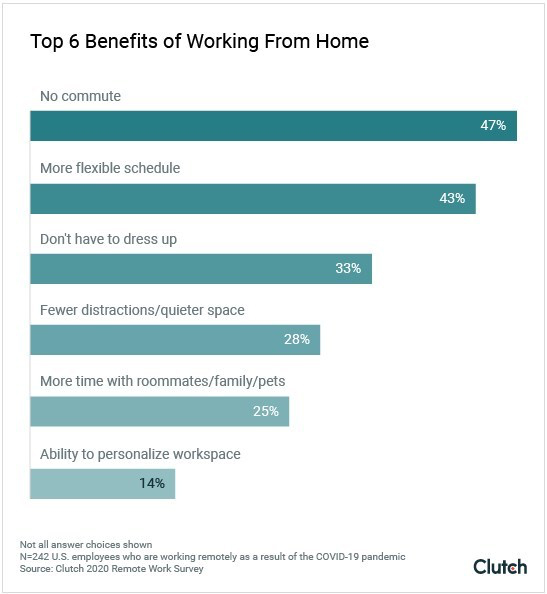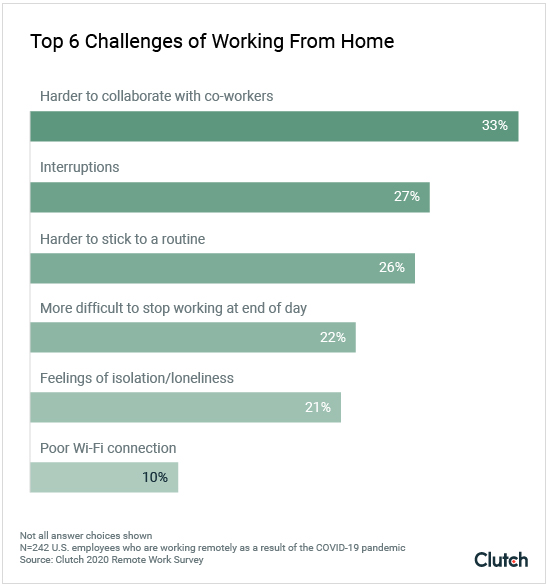While there are many benefits to remote working, there are also plenty of challenges too that potentially outweigh the benefits for many. One month into remote working, employees worldwide have had the opportunity to get a taste of the realities of working from home. A survey from B2B ratings and reviews platform Clutch has revealed that despite the benefits, remote working is actually not for everyone.
The research findings show that US employees are split on how they feel about remote working, with many actually looking forward to returning to the office. In fact, around 39% of workers would rather work from the office, while 40% prefer to work remotely, and 21% have no preference.
According to Clutch, around two-thirds (66%) of US employees are currently working remotely, at least part of the work week as a result of the coronavirus pandemic. Almost half (44%) of all workers are working from home five days or more per week, up from 17% before the pandemic. While there are many benefits of remote working, such as not having a commute and a more flexible schedule, remote working presents huge challenges too, which mainly revolve around collaborating with co-workers and frequent interruptions.
REMOTE WORK BENEFITS
Not having to commute is probably the biggest benefit of remote work. The average American spends round 4.35 hours a week commuting. So many employees are appreciating the personal time they have gained from not having a commute while working from home. Remote work brings many Americans’ commute time down to just a few seconds – literally a walk from one room to another.
This is the biggest benefit of working from home, according to US employees. With half of staff (47%) citing no commute as the biggest benefit of remote working, 43% of workers say they now get to enjoy a more flexible schedule as a result of less time spent on commuting

“I commute about an hour each way, so not commuting saves me both time and money,” said Sophie Conner, Marketing Manager of HaloITSM, a service desk software company. “With the extra time, I have been able to start running and have more time for my own hobbies.”
Like Connor, many workers are taking advantage of the hours saved from not having to commute to work. Other advantages of working from home include not having to dress up (33%), fewer distractions (28%), and more time with family, roommates and pets (25%).
CHALLENGING COLLABORATION
However, collaboration with colleagues is probably the most difficult and least favourite part of remote work. One-third of workers (33%) say it’s harder to collaborate with co-workers while working remotely. In a typical office setting, employees can ask a simple question by visiting colleagues at their desk and quickly getting an answer. Now staff have to wait until colleagues open their email or see their message before answering their question.
“Before this, I could simply ask someone a quick question when they sat next to me,” commented Charlie Worrall, Digital Marketing Executive at web design agency Imaginaire Digital. “Instead, I’ll email them, they take a while to respond, so I’ll call and it takes up a little too much time.”
To reduce communication issues, however, many companies are turning to collaboration tools such as Zoom (36%), Microsoft Teams (19%) and Skype (17%), reveals Clutch. Employees at Parlia, an online encyclopedia of opinions from around the world, uses Google Hangouts, Slack, and Asana for remote communication. “It means we get some face-time with each other, so we get those water-cooler moments even if not physically together,” explained Managing Editor Nushy Rose. “Keeping camaraderie up is essential in times like this.”
Rather than waiting for a response to an email or phone call, collaboration tools let people interact with each other in real-time, which reduces communication issues many face with remote work.
DISTRACTIONS & INTERRUMPTIONS
Frequent interruptions also pose a huge challenge to working from home. Daily distractions also make it hard for many employees to focus fully on work at home. In fact, more than one-quarter (27%) actually struggle with interruptions and distractions while working remotely, according to Clutch findings.

“There is always something to do at home: books, TV, kids and many more distractions at every turn,” said TY Hlangwane, of PR firm Magnolia Haus Communications. “It takes a truly disciplined individual to work at home.”
It’s also hard to stick to a routine for more than a quarter of remote workers (26%), and around 22% find it harder to stop working at the end of the day. However, given that social distancing could last many more weeks, even months, workforces around the world are likely to remain working from home for the foreseeable future.
REMOTE WORK POST COVID-19
The pandemic is likely to alter many company work environments permanently, according to Clutch. A few companies are already planning to allow more remote work even after the COVID-19 outbreak ends.
For example, PPC Protect, a fraud protection software firm, plans to transition to office work on a rolling basis – three days per week in the office, two days at home. “We may keep this structure if staff prefer it, as it would give a good balance between the benefits of home-working and office-based working,” stated Founder Neil Andrew.
For now working from home will be the norm for the foreseeable future – potentially lasting weeks, if not months – not just in the US but worldwide. So, Clutch advises businesses to have open conversations with employees about their successes and struggles with remote work to help make their workday as productive as possible.
Read the full Clutch report here.








































